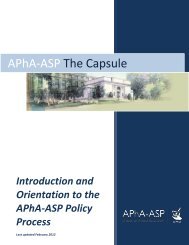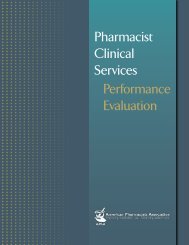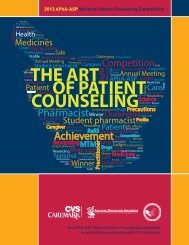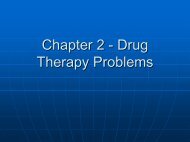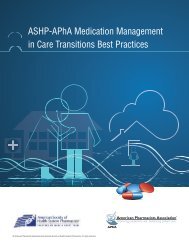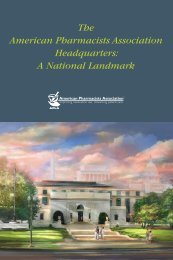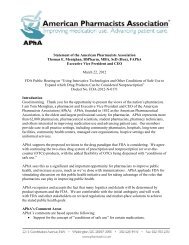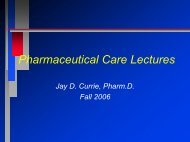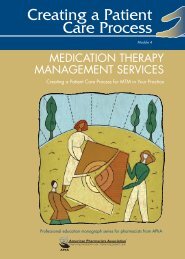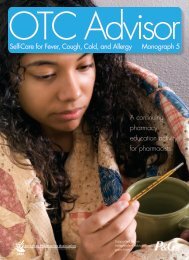Community Pharmacist Preceptor Education Program - Library
Community Pharmacist Preceptor Education Program - Library
Community Pharmacist Preceptor Education Program - Library
- No tags were found...
Create successful ePaper yourself
Turn your PDF publications into a flip-book with our unique Google optimized e-Paper software.
e provided consistently throughout the rotation, bothinformally as the needs and opportunities arise, and moreformally during scheduled discussion times.Provide frequent, individualized feedback to studentpharmacists regarding activities that have been done well,and areas that require improvement. Ideally, feedbackshould be immediate. It is easier to provide positive feedbackimmediately, but tact should be used when providingconstructive feedback on areas that need improvement.When providing a critique, it is more appropriate to takethe student pharmacist aside to privately explain issuesthat need to be addressed in a respectful manner. Thepreceptor can help the student pharmacist understand whatwent wrong and help the student pharmacist brainstormsolutions to prevent the problem from recurring.Feedback should be specific. Rather than a generalremark such as, “You did a nice job with Mrs. Smith today,”you should identify what the student pharmacist did thatworked well. For example, “Your assessment of Mrs. Smithwas excellent because you were both thorough and efficientin obtaining her medical history and asked the rightquestions to rule out other possible conditions. In addition,your body language and tone of voice seemed to convey agenuine sense of empathy.” This feedback lets the studentpharmacist know specifically what he or she did well. Alsonote areas where student pharmacists could improve suchas, “You might want to allow a little more time for thepatient to answer your questions. Although it is importantto be efficient, allowing the patient to elaborate can providevaluable information.” It is important to monitor your toneof voice to ensure that you provide constructive feedback ina supportive manner. 22Another strategy for providing feedback is to first askstudent pharmacists to report what they thought they didwell and where they could improve. This allows themthe opportunity to reflect on their actions and think ofproactive strategies to improve future performance.When providing constructive feedback, solicit thestudent pharmacist’s ideas on how to improve wheneverpossible. For example, if you notice that the studentpharmacist has a nervous habit, you could mentionit in a manner that raises awareness of the issue but isnonjudgmental. Ask, “Are you aware that you have a habitof chewing on your pen when the patient is talking?”Allow the student pharmacist to reflect on how this mightappear to patients. Then inquire, “What impression mightthis behavior give to patients?” Follow up in a mannerthat prompts the student to formulate what he or shecould do to improve rather than immediately giving yourassessment and suggested plan of action; ask, “What do youthink you could do to stop this habit?” When constructivefeedback is provided, follow up on the issue as necessary. Becertain to compliment the student pharmacist’s efforts toaddress the issue. Table 10 provides additional suggestionsfor questions that you can use to open discussions withstudents and provide feedback. 23TABLE 10. Conversation Openers forProviding Feedback to Student <strong>Pharmacist</strong>s■ What are your thoughts about your interaction with[name of patient]?■ What was your rationale for suggesting [treatment/course of action] to this patient?■ What information from the patient’s chart led youto believe that he or she required a physician’sevaluation?■ What was the most challenging experience that youhad today? What, if anything, could have been doneto improve this situation?■ Can you describe one activity or patient interactionthat you performed today that made you feel proud?Source: Reference 23.Assessing Student <strong>Pharmacist</strong>sProviding the school with your assessment ofthe student pharmacist is another critical preceptorresponsibility. Most schools have specific requirementsthat dictate how student pharmacists should be assessed.Some schools use pass/fail systems, others have elaborateranking systems with detailed criteria for assigning a rank.For example, the University of Connecticut School ofPharmacy has a specific scoring system (Table 11). Otherschools may require student pharmacists to completeadditional activities during their rotations, such aswritten examinations, objective structured clinical exams,portfolios, or intervention documentation. 4 Others providecompetency criteria and assign points and grades separatelyfrom the evaluation process. Make certain that you areaware of the meaning of each grade level and consult withthe department of experiential education if you would likeclarification.Assessment is not an activity that should beundertaken lightly. The ratings that you provide mayhave important implications for student pharmacists’advancement through pharmacy school, access toeducational opportunities, and their career. It isimportant not to let issues of personality or empathyaffect your assessment; focus on assessing performanceand achievement of the objectives. Just as it would beunethical to provide a poor assessment of a studentpharmacist simply because of a personal dislike, it isalso unethical to give a good assessment to a studentpharmacist who was unable to achieve the goals andobjectives of the rotation.<strong>Preceptor</strong>s and pharmacy schools have a responsibilityto ensure that student pharmacists who graduate and enterpharmacy practice have the necessary knowledge and skills.Regardless of the ranking you give each student pharmacist22 APhA and NACDS Foundation



